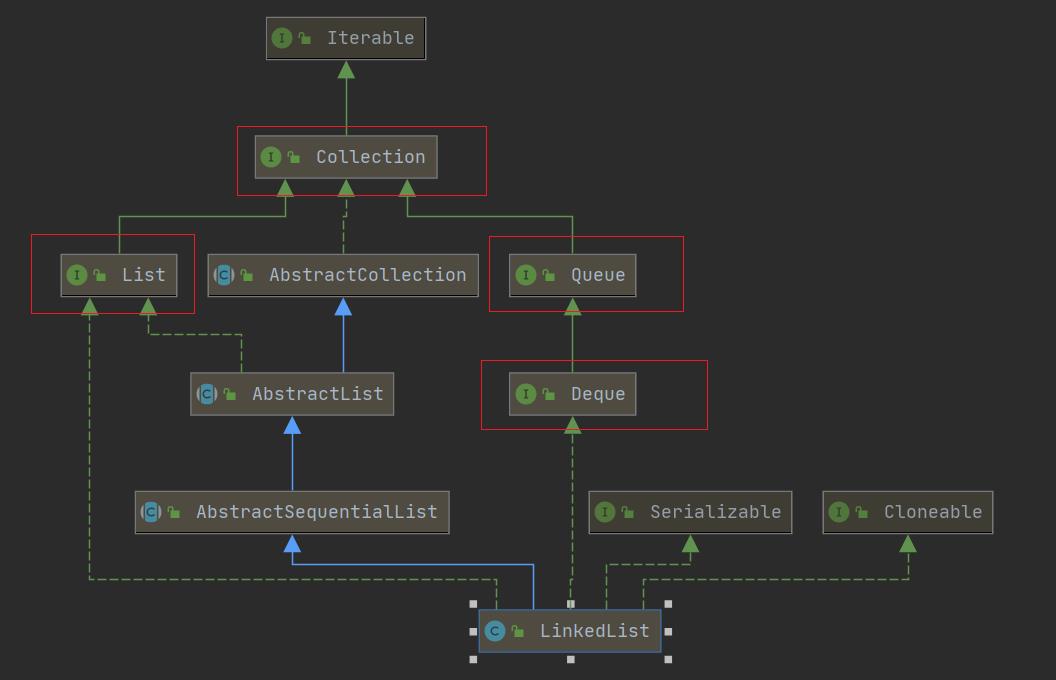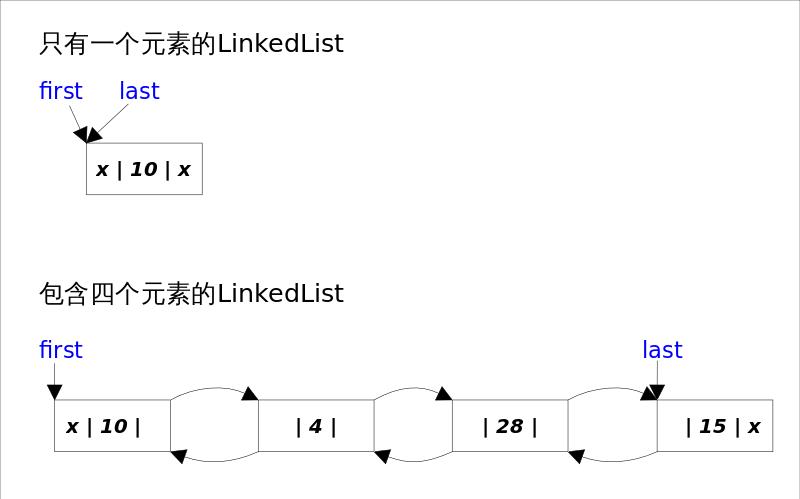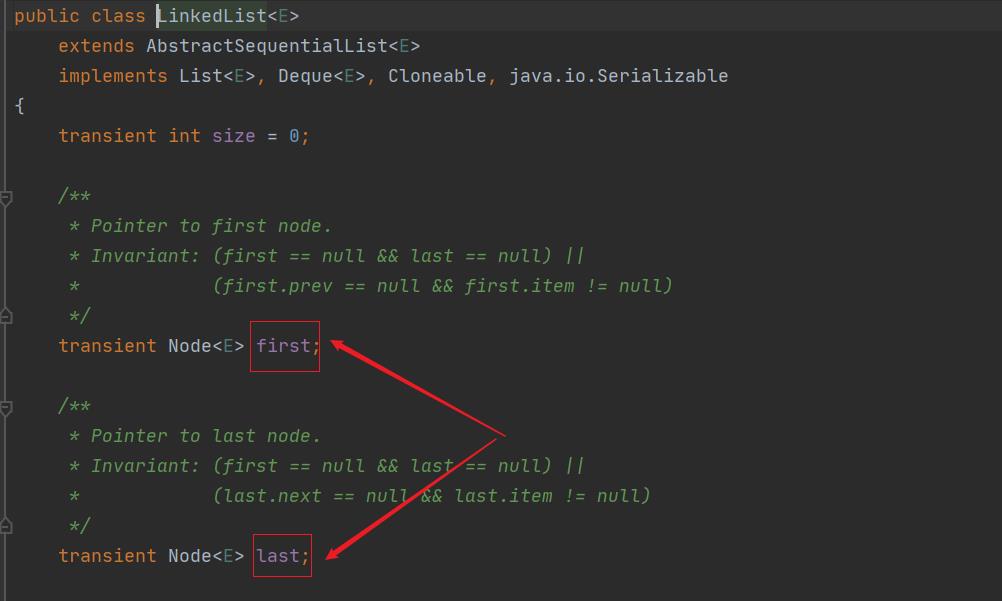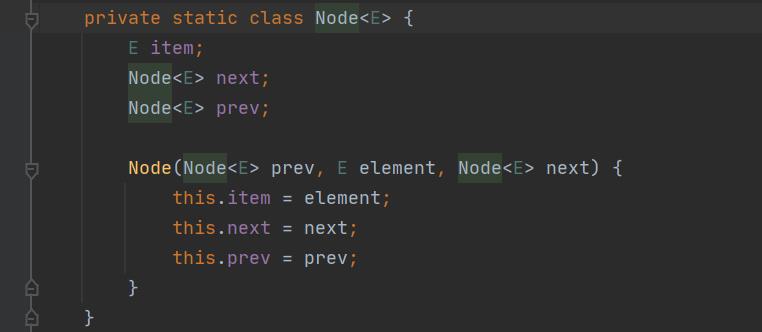Java Review - LinkedList源码解读
Posted 小小工匠
tags:
篇首语:本文由小常识网(cha138.com)小编为大家整理,主要介绍了Java Review - LinkedList源码解读相关的知识,希望对你有一定的参考价值。
文章目录

Pre
概述

从上图可知: LinkedList同时实现了List接口和Deque接口,既可以看作一个顺序容器,又可以看作一个队列(Queue),同时又可以看作一个栈(Stack) 。
当需要使用栈或者队列时,可以考虑使用LinkedList,一方面是因为Java官方已经声明不建议使用Stack类,更遗憾的是,Java里根本没有一个叫做Queue的类(它是个接口名字)。
关于栈或队列,现在的首选是ArrayDeque,它有着比LinkedList(当作栈或队列使用时)有着更好的性能。
ArrayDeque 移步 https://www.nhooo.com/java/java-arraydeque.html

LinkedList的实现方式决定了所有跟下标相关的操作都是线性时间,而在首段或者末尾删除元素只需要常数时间。
为追求效率LinkedList没有实现同步(synchronized),如果需要多个线程并发访问,可以先采用Collections.synchronizedList()方法对其进行包装。

底层数据结构-双向链表
-
LinkedList底层通过双向链表实现 。
-
双向链表的每个节点用内部类Node表示。LinkedList通过first和last引用分别指向链表的第一个和最后一个元素。
-
没有所谓的哑元,当链表为空的时候first和last都指向null。

其中Node是私有的内部类:

源码解析
构造函数

/**
* Constructs an empty list.
*/
public LinkedList()
/**
* Constructs a list containing the elements of the specified
* collection, in the order they are returned by the collection's
* iterator.
*
* @param c the collection whose elements are to be placed into this list
* @throws NullPointerException if the specified collection is null
*/
public LinkedList(Collection<? extends E> c)
this();
addAll(c);
方法源码分析
getFirst()
获取第一个元素
/**
* Returns the first element in this list.
*
* @return the first element in this list
* @throws NoSuchElementException if this list is empty
*/
public E getFirst()
final Node<E> f = first;
if (f == null)
throw new NoSuchElementException();
return f.item;
getLast()
获取最后一个元素
/**
* Returns the last element in this list.
*
* @return the last element in this list
* @throws NoSuchElementException if this list is empty
*/
public E getLast()
final Node<E> l = last;
if (l == null)
throw new NoSuchElementException();
return l.item;

remove相关方法

有两个版本,
- 一个是删除跟指定元素相等的第一个元素
remove(Object o), - 一个是删除指定下标处的元素
remove(int index)

remove(e)
【boolean remove(Object o) 】
/**
* Removes the first occurrence of the specified element from this list,
* if it is present. If this list does not contain the element, it is
* unchanged. More formally, removes the element with the lowest index
* @code i such that
* <tt>(o==null ? get(i)==null : o.equals(get(i)))</tt>
* (if such an element exists). Returns @code true if this list
* contained the specified element (or equivalently, if this list
* changed as a result of the call).
*
* @param o element to be removed from this list, if present
* @return @code true if this list contained the specified element
*/
public boolean remove(Object o)
if (o == null)
for (Node<E> x = first; x != null; x = x.next)
if (x.item == null)
unlink(x);
return true;
else
for (Node<E> x = first; x != null; x = x.next)
if (o.equals(x.item))
unlink(x);
return true;
return false;
/**
* Unlinks non-null node x.
*/
E unlink(Node<E> x)
// assert x != null;
final E element = x.item;
final Node<E> next = x.next;
final Node<E> prev = x.prev;
if (prev == null) //删除的是第一个元素
first = next;
else
prev.next = next;
x.prev = null;
if (next == null) //删除的是最后一个元素
last = prev;
else
next.prev = prev;
x.next = null;
x.item = null;
size--;
modCount++;
return element;
指的是删除第一次出现的这个元素, 如果没有这个元素,则返回false;判读的依据是equals方法, 如果equals,则直接unlink这个node;由于LinkedList可存放null元素,故也可以删除第一次出现null的元素;

remove(index)
【remove(int index)】
remove(int index)使用的是下标计数, 只需要判断该index是否有元素即可,如果有则直接unlink这个node。
/**
* Removes the element at the specified position in this list. Shifts any
* subsequent elements to the left (subtracts one from their indices).
* Returns the element that was removed from the list.
*
* @param index the index of the element to be removed
* @return the element previously at the specified position
* @throws IndexOutOfBoundsException @inheritDoc
*/
public E remove(int index)
checkElementIndex(index);
return unlink(node(index));

removeFirst()
【删除 头部元素】
/**
* Removes and returns the first element from this list.
*
* @return the first element from this list
* @throws NoSuchElementException if this list is empty
*/
public E removeFirst()
final Node<E> f = first;
if (f == null)
throw new NoSuchElementException();
return unlinkFirst(f);
/**
* Unlinks non-null first node f.
*/
private E unlinkFirst(Node<E> f)
// assert f == first && f != null;
final E element = f.item;
final Node<E> next = f.next;
f.item = null;
f.next = null; // help GC
first = next;
if (next == null)
last = null;
else
next.prev = null;
size--;
modCount++;
return element;

removeLast()
/**
* Removes and returns the last element from this list.
*
* @return the last element from this list
* @throws NoSuchElementException if this list is empty
*/
public E removeLast()
final Node<E> l = last;
if (l == null)
throw new NoSuchElementException();
return unlinkLast(l);
/**
* Unlinks non-null last node l.
*/
private E unlinkLast(Node<E> l)
// assert l == last && l != null;
final E element = l.item;
final Node<E> prev = l.prev;
l.item = null;
l.prev = null; // help GC
last = prev;
if (prev == null)
first = null;
else
prev.next = null;
size--;
modCount++;
return element;

add()

add()方法有两个版本:
- 一个是
add(E e),该方法在LinkedList的末尾插入元素,因为有last指向链表末尾,在末尾插入元素的花费是常数时间。只需要简单修改几个相关引用即可 - 另一个是
add(int index, E element),该方法是在指定下表处插入元素,需要先通过线性查找找到具体位置,然后修改相关引用完成插入操作。
/**
* Appends the specified element to the end of this list.
*
* <p>This method is equivalent to @link #addLast.
*
* @param e element to be appended to this list
* @return @code true (as specified by @link Collection#add)
*/
public boolean add(E e)
linkLast(e);
return true;
/**
* Links e as last element.
*/
void linkLast(E e)
final Node<E> l = last;
final Node<E> newNode = new Node<>(l, e, null);
last = newNode;
if (l == null)
first = newNode;
else
l.next = newNode;
size++;
modCount++;

add(int index, E element),
- 当index==size时,等同于add(E e);
- 如果不是,则分两步: 1.先根据index找到要插入的位置,即node(index)方法;2.修改引用,完成插入操作。
/**
* Inserts the specified element at the specified position in this list.
* Shifts the element currently at that position (if any) and any
* subsequent elements to the right (adds one to their indices).
*
* @param index index at which the specified element is to be inserted
* @param element element to be inserted
* @throws IndexOutOfBoundsException @inheritDoc
*/
public void add(int index, E element)
checkPositionIndex(index);
if (index == size)
linkLast(element);
else
linkBefore(element, node(index));
/**
* Inserts element e before non-null Node succ.
*/
void linkBefore(E e, Node<E> succ)
// assert succ != null;
final Node<E> pred = succ.prev;
final Node<E> newNode = new Node<>(pred, e, succ);
succ.prev = newNode;
if (pred == null)
first = newNode;
else
pred.next = newNode;
size++;
modCount++;
上面代码中的node(int index)函数有一点小小的技巧,因为链表双向的,可以从开始往后找,也可以从结尾往前找,具体朝那个方向找取决于条件index < (size >> 1),也即是index是靠近前端还是后端。
/**
* Returns the (non-null) Node at the specified element index.
*/
Node<E> node(int index)
// assert isElementIndex(index);
if (index < (size >> 1))
Node<E> x = first;
for (int i = 0; i < index; i++)
x = x.next;
return x;
else
Node<E> x = last;
for (int i = size - 1; i > index; i--)
x = x.prev;
return x;
从这里也可以看出,linkedList通过index检索元素的效率没有arrayList高
addAll()

addAll(index, c) 实现方式并不是直接调用add(index,e)来实现,主要是因为效率的问题,另一个是fail-fast中modCount只会增加1次;
/**
* Appends all of the elements in the specified collection to the end of
* this list, in the order that they are returned by the specified
* collection's iterator. The behavior of this operation is undefined if
* the specified collection is modified while the operation is in
* progress. (Note that this will occur if the specified collection is
* this list, and it's nonempty.)
*
* @param c collection containing elements to be added to this list
* @return @code true if this list changed as a result of the call
* @throws NullPointerException if the specified collection is null
*/
public boolean addAll(Collection<? extends E> c)
return addAll(size, c);
/**
* Inserts all of the elements in the specified collection into this
* list, starting at the specified position. Shifts the element
* currently at that position (if any) and any subsequent elements to
* the right (increases their indices). The new elements will appear
* in the list in the order that they are returned by the
* specified collection's iterator.
*
* @param index index at which to insert the first element
* from the specified collection
* @param c collection containing elements to be added to this list
* @return @code true if this list changed as a result of the call
* @throws IndexOutOfBoundsException @inheritDoc
* @throws NullPointerException if the specified collection is null
*/
public boolean addAll(int index, Collection<? extends E> c)
checkPositionIndex(index);
Object[] a = c.toArray();
int numNew = a.length;
if (numNew == 0)
return false;
Node<E> pred, succ;
if (index == size)
succ = null;
pred = last;
else
succ = node(index);
pred = succ.prev;
for (Object o : a)
@SuppressWarnings("unchecked") E e = (E) o;
Node<E> newNode = new Node<>(pred, e, null);
if (pred == null)
first = newNode;
else
pred.next = newNode;
pred = newNode;
if (succ == null)
last = pred;
else
pred.next = succ;
succ.prev = pred;
size += numNew;
modCount++;
return true;

clear()
为了让GC更快可以回收放置的元素,需要将node之间的引用关系赋空。
/**
* Removes all of the elements from this list.
* The list will be empty after this call returns.
*/
public void clear()
// Clearing all of the links between nodes is "unnecessary", but:
// - helps a generational GC if the discarded nodes inhabit
// more than one generation
// - is sure to free memory even if there is a reachable Iterator
for (Node<E> x = first; x != null; )
Node<E> next = x.next;
x.item = null;
x.next = null;
x.prev = null;
x = next;
first = last = null;
size = 0;
modCount++;
get相关的方法

【通过index获取元素】
// Positional Access Operations
/**
* Returns the element at the specified position in this list.
*
* @param index index of the element to return
* @return the element at the specified position in this list
* @throws IndexOutOfBoundsException @inheritDoc
*/
public E get(int index)
checkElementIndex(index);
return node(index).item;
/**
* Returns the first element in this list.
*
* @return the first element in this list
* @throws NoSuchElementException if this list is empty
*/
public E getFirst()
final Node<E> f = first;
if (f == null)
throw new NoSuchElementException();
return f.item;
/**
* Returns the last element in this list.
*
* @return the last element in this list
* @throws NoSuchElementException if this list is empty
*/
public E getLast()
final Node<E> l = last;
if (l == null)
throw new NoSuchElementException();
return l.item;
get(int index)得到指定下标处元素的引用,通过调用node(int index)方法实现
set()
将某个位置的元素重新赋值。
set(int index, E element)方法将指定下标处的元素修改成指定值,也是先通过node(int index)找到对应下表元素的引用,然后修改Node中item的值
/**
* Replaces the element at the specified position in this list with the
* specified element.
*
* @param index index of the element to replace
* @param element element to be stored at the specified position
* @return the element previously at the specified position
* @throws IndexOutOfBoundsException @inheritDoc
*/
public E set(int index, E element)
checkElementIndex(index);
Node<E> x = node(index);
E oldVal = x.item;
x.item = element;
return oldVal;
isElementIndex()
/**
* Tells if the argument is the index of an existing element.
*/
private boolean isElementIndex(int index)
return index >= 0 && index < size;
isPositionIndex()
/**
* Tells if the argument is the index of a valid position for an
* iterator or an add operation.
*/
private boolean isPositionIndex(int index)
return index >= 0 && index <= size;
查找操作
查找操作的本质是查找元素的下标
indexOf
查找第一次出现的index, 如果找不到返回-1
Java Review - PriorityQueue源码解读
Java Review - PriorityQueue源码解读
Java Review - Queue和Stack 源码解读
Java Review - Queue和Stack 源码解读